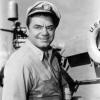|
IN MEMORY OF ACTOR ERNEST BORGNINE |
Updated: August 31, 2025


































































Ernest Borgnine was born Ermes Effron Borgnino on January 24, 1917 in Hamden, Connecticut. His parents were Anna ( Boselli ), who
had emigrated from Carpi ( MO ), Italy, and Camillo Borgnino, who had emigrated from Ottiglio ( AL ), Italy. As an only child,
Ernest enjoyed most sports, especially boxing, but took no real interest in acting. At age 18, after graduating from high school
in New Haven, and undecided about his future career, he joined the United States Navy, where he stayed for ten years until leaving
in 1945. After a few factory jobs, his mother suggested that his forceful personality could make him suitable for a career in
acting, and Borgnine promptly enrolled at the Randall School of Drama in Hartford. After completing the course, he joined
Robert Porterfield's famous Barter Theatre in Abingdon, Virginia, staying there for four years, undertaking odd jobs and playing every type of role imaginable. His big break came in 1949, when he made his acting debut on Broadway playing a male nurse in "Harvey".
In 1951, Borgnine moved to Los Angeles to pursue a movie career, and made his film debut as Bill Street in The Whistle at Eaton
Falls ( 1951 ). His career took off in 1953 when he was cast in the role of Sergeant "Fatso" Judson in From Here to Eternity
( 1953 ). This memorable performance led to numerous supporting roles as "heavies" in a steady string of dramas and westerns. He played against type in 1955 by securing the lead role of Marty Piletti, a shy and sensitive butcher, in Marty ( 1955 ). He won an Academy Award for Best Actor for his performance, despite strong competition from Spencer Tracy, Frank Sinatra, James Dean and
James Cagney. Throughout the 1950s, 1960s and 1970s, Borgnine performed memorably in such films as The Catered Affair ( 1956 ),
Ice Station Zebra ( 1968 ) and Emperor of the North ( 1973 ). Between 1962 and 1966, he played Lt. Commander Quinton McHale in the popular television series McHale's Navy ( 1962 ). In early 1984, he returned to television as Dominic Santini in the action series Airwolf ( 1984 ) co-starring Jan-Michael Vincent, and in 1995, he was cast in the comedy series The Single Guy ( 1995 ) as doorman Manny Cordoba. He also appeared in several made-for-TV movies.
Ernest Borgnine has often stated that acting is his greatest passion, and he is still working today. His amazing 61-year career ( 1951 - 2012 and continuing ) includes appearances in well over 100 feature films and as a regular in three television series, as well as voiceovers in animated films such as All Dogs Go to Heaven II ( 1996 ), Small Soldiers ( 1998 ), and a continued role in
the series SpongeBob SquarePants ( 1999 ). Between 1973 until his death, Ernest was married to Tova Traesnaes, who heads her own cosmetics company. They lived in Beverly Hills, California, where Ernest assisted his wife between film projects. When not acting, Ernest actively supported numerous charities and spoke tirelessly at benefits throughout the country. He has been awarded several honorary doctorates from colleges across the United States as well as numerous Lifetime Achievement Awards. In 1996, Ernest
purchased a bus and traveled across the United States to see the country and meet his many fans. On December 17, 1999, he presented the University of North Alabama with a collection of scripts from his film and television career, due to his long friendship with North Alabama alumnus and actor George Lindsey ( died May 6, 2012 ), who was an artist in residence at North Alabama.
Ernest Borgnine passed away aged 95 on July 8, 2012, at Cedars-Sinai Medical Center in Los Angeles, California, of renal failure.
He is survived by his wife Tova, their children and his younger sister Evelyn ( 1926-2013 ).
|
 HOME
HOME
 About
About
 EMail Me
EMail Me TOP |
TOP |  PREVIOUS ITEM | NEXT ITEM
PREVIOUS ITEM | NEXT ITEM  ( 21 of 174 )
( 21 of 174 )


































































